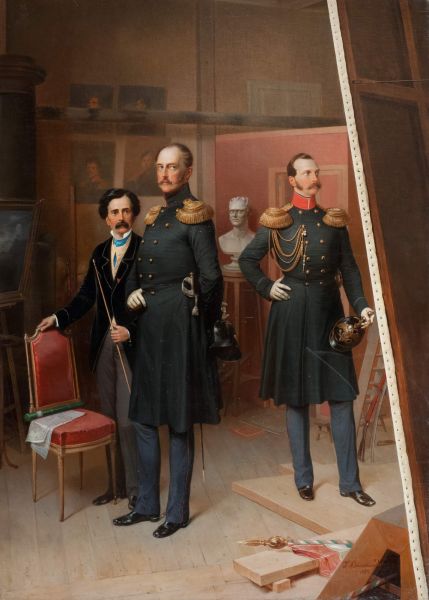|
|
Nicholas I and Tsesarevich Alexander in an Artist’s Studio in 1854

Willewalde Bogdan,
Oil on canvas
112 х 81
State Russian Museum
Annotation
A leading Russian battle-painter, Gottfried Willewalde was also one of the favourite artists of Nicholas I. The Russian Emperor highly rated his outstanding knowledge of military matters, virtuoso draughtsmanship and the meticulous Teutonic pedantry with which he depicted military parades and battles. From the geographical relief to the buttons on the uniforms, everything exactly reflected the military statutes and documental descriptions. Nicholas I was a frequent visitor to the artist’s studio. Willewalde later captured the emperor’s 1854 visit on canvas, exhibiting it in 1885 at the Imperial Academy of Arts. Painted in the artist’s trademark slightly arid and documental style, these “mementos” of the Emperor’s visits were possibly linked to the thirtieth anniversary of his death, painted by the artist in tribute to the man who had done so much to help his career. The painting was acquired by Alexander III at the exhibition.
Author's Biography
Willewalde Bogdan
Willewalde, Bogdan (Gottfried)
1818 (1819?), ? – 1903, Dresden
Painter, battle painter, genre artist, portraitist, landscapist. Studied under Karl Brullov and Alexander Sauerweid at the Imperial Academy of Arts (1843–1844). Taught at the School of Drawing, Society for the Encouragement of Artists, St Petersburg (1840–1842). Contributed to exhibitions (from 1842). Foreign fellow of the Imperial Academy of Arts (1843–1844). Summoned to St Petersburg by order of Nicholas I to complete works commissioned from deceased Alexander Sauerweid (1864). Appointed teacher of drawing for Grand Dukes Nicholas Nikolayevich and Michael Nikolayevich. Taught at the school of the Society of St Petersburg Artists (1840–1842). Taught at the Imperial Academy of Arts (1848–1894). Academician of painting (from 1845), professor of battlepainting (from 1848), member of the Academy Council (from 1859), first-class professor (с 1872). Professor emeritus (1888).

